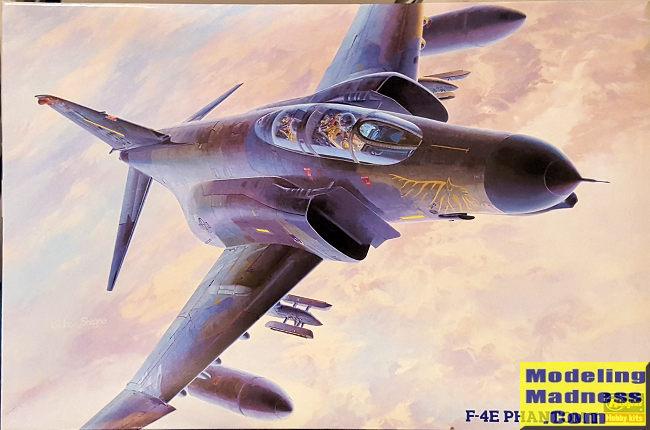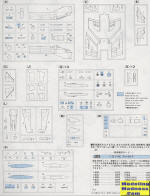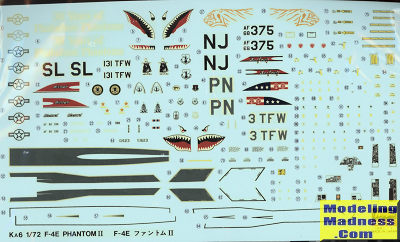
Hasegawa 1/72 F-4E Phantom II
| KIT #: | 04305 (Kx5) |
| PRICE: | 2200 yen when new |
| DECALS: | Three options |
| REVIEWER: | Scott Van Aken |
| NOTES: | 1996 boxing |

| HISTORY |
| THE KIT |
 This
is the third generation of F-4 produced by Hasegawa. First was an F-4D/J that is
best forgotten and is really only useful to collectors or those who want a
nostalgia build. The second generation kit was an F-4E/F that is still in the
catalogue. It is not a bad kit, but is not up to modern standards. Still, it
makes into a presentable model for those on a budget. This is the third
generation tooling from the mid-1990s and takes advantage of the current way
kits are developed. That means you have a base kit with the ability to take a
lot of inserts and other small bits to build up to what is on the box top. It
also means you'll have spare parts that are not needed.
This
is the third generation of F-4 produced by Hasegawa. First was an F-4D/J that is
best forgotten and is really only useful to collectors or those who want a
nostalgia build. The second generation kit was an F-4E/F that is still in the
catalogue. It is not a bad kit, but is not up to modern standards. Still, it
makes into a presentable model for those on a budget. This is the third
generation tooling from the mid-1990s and takes advantage of the current way
kits are developed. That means you have a base kit with the ability to take a
lot of inserts and other small bits to build up to what is on the box top. It
also means you'll have spare parts that are not needed.
You get a fairly nice cockpit that has a proper seat shape and uses decals for instruments. This fits into a separate nose section that is split vertically. The nose is then attached and that assembly set aside. One then moves on to the aft fuselage. This includes the fin and once joined, the nose section is attached along with the intakes, proper fin cap and the horizontal stabs. Note that depending on the marking option you choose, you'll have to open holes or use alternate parts so a decision in this regard needs to be done early.
The lower wing needs various holes opened and then the upper
wing halves attached. The outer wing sections are separate and with that
assembled, it and the exhaust are glued in place. The instructions then have you
attach the clear parts. You can pose the two canopy sections open or closed as
you choose. Landing gear and doors are nicely done and fit securely. These F-4s
are all later versions with the extended slats and the actuator fairings have to
be attached. For thins under wings you have a pair of Sidewinder rails for the
pylons, outer fuel tanks, and the later F-15 style centerline. Note that the
plane did not always fly with all three tanks so check photos to see which is
more appropr iate
for you before you open those wing holes for them. As a note, the F-4 does not
require any nose weight.
iate
for you before you open those wing holes for them. As a note, the F-4 does not
require any nose weight.
Instructions are standard fare with Gunze paint references. There are three options provided. The box art plane is from the New Jersey ANG and is in the Euro 1 paint scheme. Next is the Missouri ANG 30th Anniversary plane in the Hill Grey II camouflage. Also in these colors is a 3TFW aircraft that was based in the Philippines. Decals are nicely printed and are 'old school' Hasegawa which means a bit thick and with the whites in an off-white shade. There are TONS of F-4E aftermarket sheets so you should have no issues finding replacements.
| CONCLUSIONS |
Considering that the F-4E/F was the most widely built version of the Phantom II, it is a bit odd that there are not a lot of kits of it, compared to the F-4B/C/D/J. Currently Revell, Fujimi, and Hasegawa are pretty much it. Those who might comment that 'only the F-4EJ is easy to find', keep in mind that all the US F-4E bits are in the box as well. This is a somewhat fussy kit to build thanks to the inserts, but is not difficult. The EJ kit is fairly easy to find so snag one along with your favorite decals and go for it.
February 2020
Copyright ModelingMadness.com. All rights reserved. If you would like your product reviewed fairly and fairly quickly, please
contact
the editor or see other details in the
Note to
Contributors. Back to the Main Page
Back to the Review
Index Page
Back to the Previews Index Page